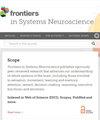不同大脑状态下大规模时空活动模式的分布差异
IF 3.5
4区 医学
Q2 NEUROSCIENCES
引用次数: 0
摘要
静息状态功能磁共振成像(rs-fMRI)中观察到的大部分空间结构都是由大脑活动的几种大规模时空模式(准周期模式或 QPPs)构成的。QPPs 捕获了众所周知的特征,如全局信号的演变以及默认模式和任务积极网络的交替主导地位。这些广泛的活动模式可能与神经调节输入有关,而神经调节输入会介导包括唤醒和注意力在内的非局部过程的变化。为了确定 QPPs 是否在不同大脑条件下表现出差异,我们在两种情况下对三种最强 QPPs 的相对强度和分布进行了研究。首先,根据人类连接组计划的数据,在扫描过程中检查了QPPs的相对发生率和强度,假设嗜睡程度的增加会使QPPs的表达随时间发生变化。其次,在三种不同的麻醉条件下,使用一种能最大限度减少噪声的新方法获得的大鼠 rs-fMRI 检查了 QPPs 的相对发生率和幅度,预计这三种麻醉条件会产生不同类型的大脑活动。结果表明,QPPs 的分布及其大小会随着大脑状态的变化而变化,这证明了这些大规模模式对与大脑状态改变相关的广泛变化的敏感性。本文章由计算机程序翻译,如有差异,请以英文原文为准。
Variation in the distribution of large-scale spatiotemporal patterns of activity across brain states
A few large-scale spatiotemporal patterns of brain activity (quasiperiodic patterns or QPPs) account for most of the spatial structure observed in resting state functional magnetic resonance imaging (rs-fMRI). The QPPs capture well-known features such as the evolution of the global signal and the alternating dominance of the default mode and task positive networks. These widespread patterns of activity have plausible ties to neuromodulatory input that mediates changes in nonlocalized processes, including arousal and attention. To determine whether QPPs exhibit variations across brain conditions, the relative magnitude and distribution of the three strongest QPPs were examined in two scenarios. First, in data from the Human Connectome Project, the relative incidence and magnitude of the QPPs was examined over the course of the scan, under the hypothesis that increasing drowsiness would shift the expression of the QPPs over time. Second, using rs-fMRI in rats obtained with a novel approach that minimizes noise, the relative incidence and magnitude of the QPPs was examined under three different anesthetic conditions expected to create distinct types of brain activity. The results indicate that both the distribution of QPPs and their magnitude changes with brain state, evidence of the sensitivity of these large-scale patterns to widespread changes linked to alterations in brain conditions.
求助全文
通过发布文献求助,成功后即可免费获取论文全文。
去求助
来源期刊

Frontiers in Systems Neuroscience
Neuroscience-Developmental Neuroscience
CiteScore
6.00
自引率
3.30%
发文量
144
审稿时长
14 weeks
期刊介绍:
Frontiers in Systems Neuroscience publishes rigorously peer-reviewed research that advances our understanding of whole systems of the brain, including those involved in sensation, movement, learning and memory, attention, reward, decision-making, reasoning, executive functions, and emotions.
 求助内容:
求助内容: 应助结果提醒方式:
应助结果提醒方式:


